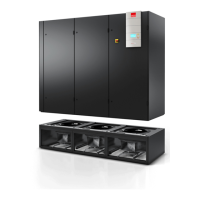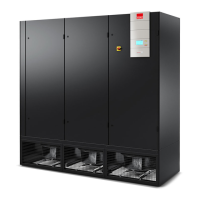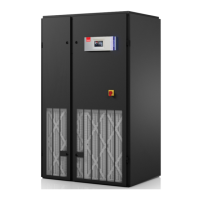Do you have a question about the Stulz CyberAir DX Series and is the answer not in the manual?
Explains the use of notes, cautions, and warnings in the manual for operational and safety information.
Provides general guidelines, warnings, and cautions for installation, operation, and maintenance procedures.
Covers safe lifting practices and electrical hazards associated with the unit, emphasizing caution.
Details safety precautions for handling refrigerants, solvents, and chemicals, including exposure risks.
Details access to the electrical enclosure, safety interlocks, and component protection devices.
Explains the two-stage cooling system with staged compressor operation based on temperature set points.
Describes how free-cooling minimizes compressor use by utilizing a remote drycooler for energy savings.
Explains the use of an independent chilled water source for cooling, with DX circuit assist if needed.
Covers preparing the installation site, including clearances, space conditioning, and insulation.
Covers general requirements for refrigerant piping installation, including brazing and slope.
Provides tables and guidance for sizing refrigerant lines for R-410A based on equivalent length.
Details examining the unit nameplate and making main power connections according to electrical codes.
Introduces refrigerant charging procedures and discusses R-410A properties and safety.
Explains how to estimate refrigerant needs by adding unit, condenser, and piping charge weights.
Details leak testing, evacuation, and vacuum procedures required before refrigerant charging.
Guides on performing the initial refrigerant charge by introducing liquid refrigerant to the system.
Explains how to add refrigerant while the unit is running to achieve correct superheat and sub-cooling.
Details using variable fan speed control to maintain head pressure in air-cooled systems at low ambient temperatures.
Explains flooded head pressure control using a receiver and valve for low ambient conditions.
Guides on preparing for and performing initial operation using the completed installation checklist.
Provides detailed step-by-step instructions for starting up the unit, including testing functions.
Outlines routine maintenance tasks for optimal performance, including filter replacement and connection checks.
Details troubleshooting for compressor failures, including starting issues, short cycling, and noise.
Describes methods for detecting refrigerant leaks using electronic detectors or soapy water and repair steps.
Explains how to diagnose compressor failures (electrical vs. mechanical) and general repair procedures.
Outlines the procedure for cleaning the system after a compressor burnout, including acid removal.
Details the process for obtaining warranty replacement parts, including required documentation.
Provides a comprehensive checklist for verifying all installation tasks have been completed correctly.
Explains the use of notes, cautions, and warnings in the manual for operational and safety information.
Provides general guidelines, warnings, and cautions for installation, operation, and maintenance procedures.
Covers safe lifting practices and electrical hazards associated with the unit, emphasizing caution.
Details safety precautions for handling refrigerants, solvents, and chemicals, including exposure risks.
Details access to the electrical enclosure, safety interlocks, and component protection devices.
Explains the two-stage cooling system with staged compressor operation based on temperature set points.
Describes how free-cooling minimizes compressor use by utilizing a remote drycooler for energy savings.
Explains the use of an independent chilled water source for cooling, with DX circuit assist if needed.
Covers preparing the installation site, including clearances, space conditioning, and insulation.
Covers general requirements for refrigerant piping installation, including brazing and slope.
Provides tables and guidance for sizing refrigerant lines for R-410A based on equivalent length.
Details examining the unit nameplate and making main power connections according to electrical codes.
Introduces refrigerant charging procedures and discusses R-410A properties and safety.
Explains how to estimate refrigerant needs by adding unit, condenser, and piping charge weights.
Details leak testing, evacuation, and vacuum procedures required before refrigerant charging.
Guides on performing the initial refrigerant charge by introducing liquid refrigerant to the system.
Explains how to add refrigerant while the unit is running to achieve correct superheat and sub-cooling.
Details using variable fan speed control to maintain head pressure in air-cooled systems at low ambient temperatures.
Explains flooded head pressure control using a receiver and valve for low ambient conditions.
Guides on preparing for and performing initial operation using the completed installation checklist.
Provides detailed step-by-step instructions for starting up the unit, including testing functions.
Outlines routine maintenance tasks for optimal performance, including filter replacement and connection checks.
Details troubleshooting for compressor failures, including starting issues, short cycling, and noise.
Describes methods for detecting refrigerant leaks using electronic detectors or soapy water and repair steps.
Explains how to diagnose compressor failures (electrical vs. mechanical) and general repair procedures.
Outlines the procedure for cleaning the system after a compressor burnout, including acid removal.
Details the process for obtaining warranty replacement parts, including required documentation.
Provides a comprehensive checklist for verifying all installation tasks have been completed correctly.
| Brand | Stulz |
|---|---|
| Model | CyberAir DX Series |
| Category | Air Conditioner |
| Language | English |











